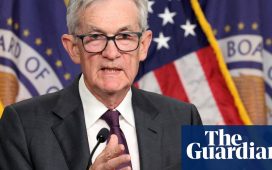Unlock the Editor’s Digest for free
Roula Khalaf, Editor of the FT, selects her favourite stories in this weekly newsletter.
The writer is a former investment banker and author of ‘Power Failure: The Rise and Fall of an American Icon’
There’s a lot of unjustified hand-wringing these days among economists, and others, about how quickly interest rates have risen in the wake of the Federal Reserve’s 18-month-long campaign to reverse its easy-money policies that followed the financial crisis of 2008.
But not from Steve Schwarzman, the billionaire co-founder of the uber-successful Blackstone Group. Few would question his intelligence or investing prowess. In an August interview, he extolled the virtues of an investment he had found of senior secured debt that was yielding close to 13 per cent.
“For those of you who are not financial people,” he told me, “it doesn’t get simpler than lending somebody senior debt and have the security of all their assets and make 13 per cent. How wonderful.”
Yes, interest rates have risen sharply, hammering many investors by pushing the price of existing bonds lower. The 10-year US Treasury bond yield — the benchmark of all financial market benchmarks — has risen from less than 0.5 per cent around the start of the Covid-19 pandemic in 2020 to 4.9 per cent, a 16-year high. In 2022 alone, global bonds lost 31 per cent. That was the worst annual performance in data stretching back to 1900, according to the long-running Credit Suisse Global Investment Returns Yearbook.
Niall Ferguson, the historian, also recently noted that US bond investors suffered their worst rout for 150 years with a return of negative 15.7 per cent, the worst since 1871.
But, hello, what did the hand-wringers expect to happen after central banks around the world manipulated down interest rates to their lowest levels in recorded history between 2009 and 2022? Did they really think there would be no financial consequences to keeping interest rates at or near zero for more than a decade? Or that the Great Unwinding of the Fed’s relentless policy of zero interest rates would be painless?
The Fed’s balance sheet exploded 10-fold to house nearly $9tn in assets in 2022, from some $900bn in assets before the 2008 financial crisis. That was intentional — and resulted from then Fed chair Ben Bernanke’s decision to have the US central bank become the buyer of last resort for all kinds of corporate and government debt that was larding up the balance sheets of Wall Street’s teetering financial institutions. The process, which Bernanke dubbed the Orwellian “quantitative easing”, had the intended effect of causing bond prices to soar and the yields on bonds to fall dramatically.
The idea, and not a bad one at least at the beginning, was to make the cost of money so cheap that people and businesses would start borrowing again — helping to ease the global recession. And that it would further alleviate the stress on the surviving Wall Street banks by giving them a deep-pocketed buyer for their distressed assets.
But it was too much of a good thing. Bernanke’s two successors, Janet Yellen and Jay Powell, kept up the bond buying, in part to appease the traders, borrowers and people making money from money, all of whom had become addicted to cheap money.
Honestly though, who in their right mind thought it was a swell idea in September 2021 to buy high-yield bonds — or “junk bonds” — when they were yielding less than a piddling 4 per cent? Junk bonds are called junk bonds for a reason: They are issued by companies with less-than-stellar credit and represent a fair amount of risk.
If a high-yield bond is yielding less than 4 per cent, when it should justifiably be yielding 10 per cent or more, something is very wrong with the risk/reward ratio. It didn’t take a genius to see that bond yields could only go up from there. And, no surprise, that is exactly what has happened. The average yield on a junk bond is closer to 9.2 per cent, according to the Federal Reserve Bank of St Louis.
Apparently, this obvious and inevitable move up in interest rates has come as a shock to many people. Take for instance, the corporate bozos behind Silicon Valley Bank, which failed spectacularly this year. Among the reasons why, it turned out, was that the bank’s executives had loaded up its balance sheet with long-term bonds bought at the peak of the market using customer deposits.
But at last we are seeing a return to a world where risk and return can be priced in a more real way after the distortions of recent years caused by the huge interventions by the Fed. The market will determine a more proper reward for the risk of owning a risky bond, not artificial demand generated by Washington bureaucrats. That will work for the long-term benefit of both investors and the financial sector. And as Schwarzman points out, there will be plenty of buying opportunities.








